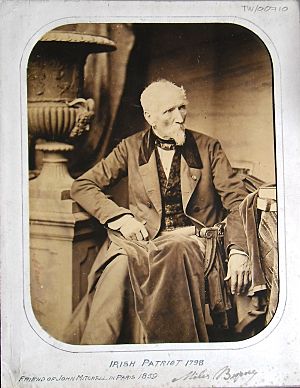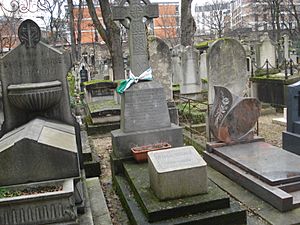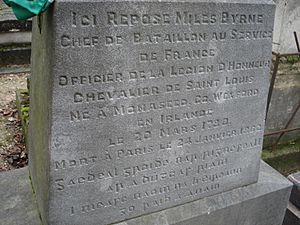Myles Byrne facts for kids
Quick facts for kids
Miles Byrne
|
|
|---|---|
 |
|
| Born | 20 March 1780 |
| Died | 24 January 1862 (aged 81) |
| Resting place | Montmartre Cemetery, Paris. |
| Occupation | Soldier. |
| Known for | Irish Rebel (1798) |
| Political party | |
| Spouse(s) | Fanny Horner |
Myles (or Miles) Byrne (born March 20, 1780 – died January 24, 1862) was an important leader in the Irish Rebellion of 1798 in Wexford. He continued to fight against the British government in the Wicklow Hills until 1802.
In 1803, he worked closely with Robert Emmet on plans for a new uprising in Dublin. When these plans didn't work out, he joined Napoleon’s Irish Legion as a soldier. He fought in battles in the Low Countries, Spain, and at the Battle of Leipzig.
Later, he retired as a chef de bataillon (a type of battalion leader). In his older years, he wrote for an Irish newspaper called The Nation. He also wrote his life story, called his memoirs. In these writings, he showed the United Irishmen as a strong group working for a democratic government in Ireland.
Contents
Early Life of Miles Byrne
Myles Byrne was born on March 20, 1780. His family were Catholic farmers. He grew up in a place called Ballylusk near Monaseed in County Wexford, Ireland.
Miles Byrne and the 1798 Rebellion
When he was 17, Myles Byrne was asked to join the government's local army, called the Yeomanry. Instead, he chose to join the Society of United Irishmen. This group wanted Ireland to be independent. They also wanted a government that represented all the people.
At 18, Byrne fought in the 1798 Rebellion. He was at the Battle of Tubberneering on June 4. He also led a group of pikemen in the attack on Arklow on June 9. The rebel leader Father Michael Murphy was killed there. Byrne also led a charge at the Battle of Vinegar Hill on June 21. This was when the rebels were being defeated.
After these battles, Byrne kept a small group of fighters together. They took over Goresbridge on June 23. However, some of his men harmed prisoners. This was in revenge for harsh acts done by the government's soldiers against the local people. After more small fights, he joined Joseph Holt and Michael Dwyer. They went to the Wicklow Hills to continue their resistance. They used small, surprise attacks.
Joseph Holt later agreed to be sent to Australia. Byrne, with help from his sister, escaped to Dublin. He remembered his sister's bravery. She was threatened by a soldier who wanted to know where Byrne was hiding. Other soldiers had to stop him from hurting her.
The 1803 Rising in Dublin
In the winter of 1802-1803, Byrne joined Robert Emmet and Anne Devlin. They were planning another uprising. In his memoirs, Byrne wrote about a meeting he set up. It was between Robert Emmet and another rebel leader, Thomas Cloney. This meeting happened in Harold's Cross Green in Dublin. Byrne said it was amazing to see "two heroic patriots" discussing how to free Ireland.
In July 1803, their plans started to fall apart. Michael Dwyer, who was still fighting in Wicklow, realized there were not enough weapons. Also, there was no clear sign that French help would arrive. In the north, other leaders found little support for a new fight.
In Dublin, an accidental explosion revealed their weapons storage. Emmet decided to go ahead with a plan to take over government buildings. The uprising was quickly stopped after a short fight in Thomas Street. Byrne was there with Emmet. Emmet ordered his men to scatter.
Serving France as a Soldier
Two days after the fight in Thomas Street, Byrne met with Emmet. He agreed to go to Paris to ask France for help. But in Paris, Napoleon was focused on other things. He was not interested in helping Ireland at that time.
Byrne became a captain in Napoleon's Irish Legion. He believed that "all Catholic Ireland" was ready to fight if they had support. But the Irish exiles in France could not convince Napoleon to focus on Ireland. So, Byrne fought in the Low Countries, Germany, and Spain with his Irish group.
Byrne became a brigadier general and received the Legion of Honour award in 1813. After Napoleon's rule ended, Byrne almost got sent away from France. This was because he supported Napoleon. But he was helped by important people and became a French citizen in 1817.
For about ten years, Byrne was mostly retired. He returned to military service in 1828. He fought well in the French mission to Morea during the Greek War of Independence. He retired in 1835 as a Chef de Bataillon (battalion leader).
Miles Byrne's Memoirs
In the 1840s, Byrne wrote from Paris for The Nation. This was a newspaper in Dublin for the Young Ireland movement. This newspaper helped to remember the United Irishmen.
In his final years, Byrne wrote his Memoirs. These books tell about his part in the Irish rebellion. They also describe his time in Napoleon's Irish Legion. They were first published in 1863 after his death. His wife, Fanny, helped with this. Many copies have been printed since then.
Stephen Gwynn edited a new version of Byrne’s Memoirs in 1907. He said that John Dillon called them "the best of all books dealing with Ireland." Gwynn agreed after reading them.
Some people thought the 1798 Rebellion was just a series of separate small fights. But Byrne's memoirs showed the United Irishmen as a strong, united group. He said they wanted a democratic, non-religious republic. He believed many Irish people supported this goal.
His Marriage and Family
Byrne married Frances Charles Horner (known as Fanny) in 1835 in Paris. She was from Scotland. They did not have any children. Fanny's father was a merchant from Edinburgh. Her mother was Joanna Baillie. They married on Christmas Eve, December 24, 1835. This was at the British Embassy Chapel in Paris.
Fanny had three brothers and two sisters. One of her brothers was Francis Horner, a member of Parliament. Another brother, Leonard Horner, was a famous geologist.
A Photograph from 1859
A photograph of Byrne can be seen in a book by Nicholas Furlong. It was taken in Paris in 1859. Some thought it was the first photo ever taken of an Irishman. However, an earlier photo of Irish poet Thomas Moore was taken in 1844.
The photograph of Byrne is possibly the only one of a United Irish veteran. It is now kept at Áras an Uachtaráin. This is the home of the President of Ireland in Dublin.
John Mitchel visited Byrne when he was 80 years old. He said Byrne was "One of those rare beings who never grow old."
Miles Byrne's Death
Miles Byrne passed away at his home in Paris on Friday, January 24, 1862. He was buried in Montmartre Cemetery. A Celtic Cross marks his grave. This headstone seems to be a newer one from the 1950s. The words on his first headstone are written in his Memoirs. Part of it said:
SINCEREMENT ATTACHE A L'lRLANDE
SON PAYS NATAL,
IL A FIDELEMENT SERVI LA FRANCE
SA PATRIE ADOPTIVE.
This means: 'Sincerely attached to Ireland, his country of birth, he faithfully served France, his country of adoption.'



